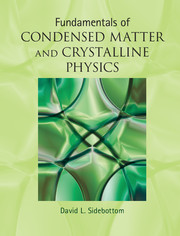 Fundamentals of Condensed Matter and Crystalline Physics
Fundamentals of Condensed Matter and Crystalline Physics from Part III - Dynamics
Published online by Cambridge University Press: 05 August 2012
Introduction
In Chapter 5 we introduced the structure factor, S(q), as the Fourier representation of the positions of a collection of fixed, elastically scattering, particles. In reality, these particles are rarely fixed. In a solid (crystal or glass), the particles are bound together by bonds and, while unable to wander about, are able to oscillate or vibrate about a fixed center of motion. In a liquid, the particles are even less constrained and are free to wander around over considerable distances. In this chapter we develop the dynamic structure factor as a straightforward extension of the static structure factor introduced previously, and apply it to examine the dynamics of liquid-like systems. In one instance, we consider the Brownian diffusion of macromolecules in a solvent, where the motion mimics that of the random walk we discussed in the previous chapter. In another instance, we show how thermodynamically driven density fluctuations present in a simple liquid are responsible for the characteristic Rayleigh–Brillouin spectrum of light scattering. We also take this opportunity to consider the special case of slow dynamics in polymer liquids and to briefly consider the nature of the liquid-to-glass transition that separates amorphous solids from their liquid counterparts.
Dynamic structure factor
We can think of a liquid as a time-dependent amorphous structure. In many ways, the structure of a liquid resembles the structure of a glass in that, at any instant in time, a “snapshot” of its S(q) resembles that of the glass. Indeed, the only real difference between a liquid and a glass is the presence or absence, respectively, of long-range translational motion. In the liquid, the translational motion results from the incessant jostling of the particles allowing them to wander about. By virtue of this motion, particles of the liquid are able to rearrange on some characteristic time scale (related to the viscosity of the liquid) into different, but thermodynamically equivalent, amorphous configurations whose instantaneous structure resembles that of a glass. For certain glass forming liquids near their glass transition point, the characteristic time scale for these rearrangements can become exceedingly long with some unusual consequences, as we will discuss later.
To save this book to your Kindle, first ensure [email protected] is added to your Approved Personal Document E-mail List under your Personal Document Settings on the Manage Your Content and Devices page of your Amazon account. Then enter the ‘name’ part of your Kindle email address below. Find out more about saving to your Kindle.
Note you can select to save to either the @free.kindle.com or @kindle.com variations. ‘@free.kindle.com’ emails are free but can only be saved to your device when it is connected to wi-fi. ‘@kindle.com’ emails can be delivered even when you are not connected to wi-fi, but note that service fees apply.
Find out more about the Kindle Personal Document Service.
To save content items to your account, please confirm that you agree to abide by our usage policies. If this is the first time you use this feature, you will be asked to authorise Cambridge Core to connect with your account. Find out more about saving content to Dropbox.
To save content items to your account, please confirm that you agree to abide by our usage policies. If this is the first time you use this feature, you will be asked to authorise Cambridge Core to connect with your account. Find out more about saving content to Google Drive.